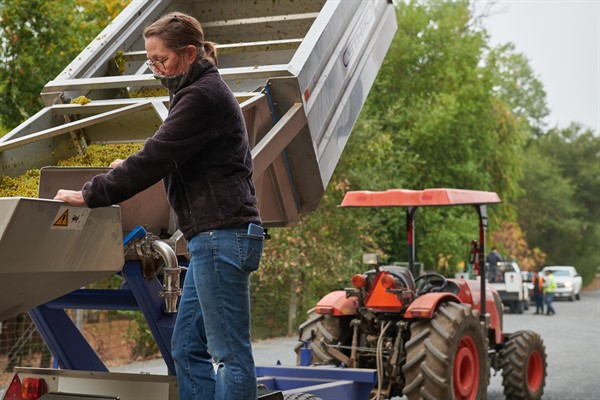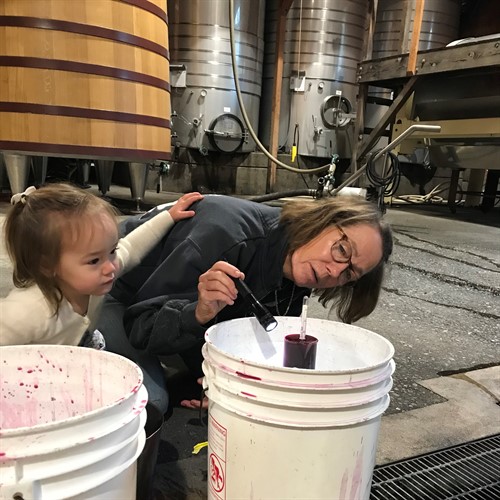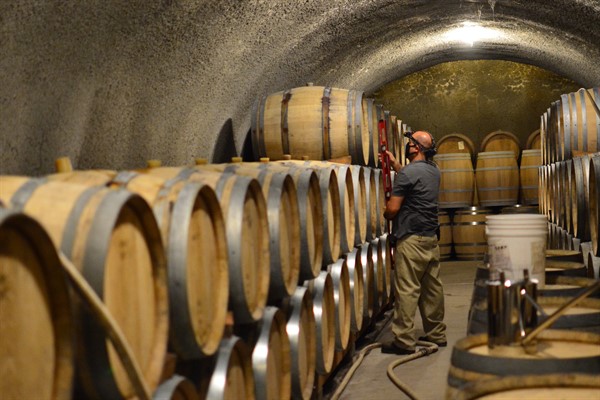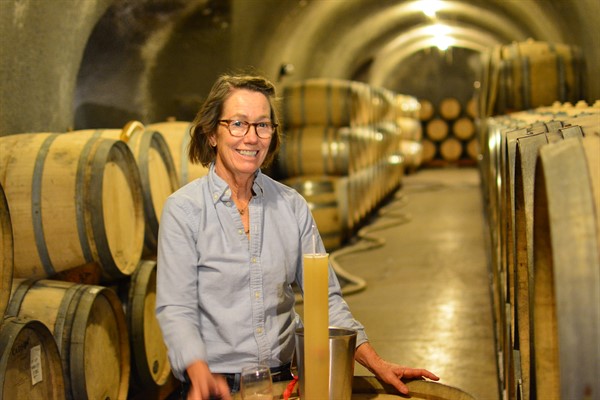Reflections on Harvest
- December 8, 2020
As the Holidays approach, harvest seems a distant memory…for most, harvest means the actual day of picking the fruit, but for those of us on the production team harvest means so much more. Harvest mode begins about 2-3 weeks before we receive any grapes. We prep the cellar and the lab, and we taste the fruit. Deciding when to pick determines the outcome of the vintage and it is a decision that we don’t take lightly. By tasting the fruit well before it’s ready, we are able to see how the flavors evolve and develop. We are fortunate here at Hafner Vineyard because we control both the vineyard and the winery. Our decisions are based on receiving the best quality of fruit, not on whether we have an available harvest crew or tank space. And if we pick a gondola and decide that the fruit isn’t quite perfect, we can stop harvesting and wait for a few more days which is exactly what we did this year. Harvest days are always fun and full of excitement. Once the fruit is in the presses (if it is white) or in the tanks (if it is red), our work begins in earnest. Parke analyzes each lot to check the acidity and pH. We then inoculate with yeast and nutrients (if needed) and the fermentations begin. Monitoring each lot of wine is one of my jobs. Every day, I take samples to test the rate of fermentation. Initially, I use a refractometer (which refracts light) to measure the sugar and as the fermentation begins, I use a hydrometer (which measures the density of the liquid). My assistant/granddaughter Marie sometimes helps.
Harvest days are always fun and full of excitement. Once the fruit is in the presses (if it is white) or in the tanks (if it is red), our work begins in earnest. Parke analyzes each lot to check the acidity and pH. We then inoculate with yeast and nutrients (if needed) and the fermentations begin. Monitoring each lot of wine is one of my jobs. Every day, I take samples to test the rate of fermentation. Initially, I use a refractometer (which refracts light) to measure the sugar and as the fermentation begins, I use a hydrometer (which measures the density of the liquid). My assistant/granddaughter Marie sometimes helps.  I also taste every lot of wine to make sure that it is progressing well. I know what you’re thinking, that’s hard work, but someone’s got to do it and I’m glad it’s me! This year, our first pick was on August 10 and our last pick was October 14. Our primary fermentations (sugar to alcohol) went from August 14 to November 8. Some lots went fast and finished fermenting in 15 days; others took longer; I have one lot that fermented slowly, never stopping, but it took 8 weeks to get to dryness. Once the sugar has dropped below zero, I test the wines with another analysis technique to make sure the wines are completely dry.
I also taste every lot of wine to make sure that it is progressing well. I know what you’re thinking, that’s hard work, but someone’s got to do it and I’m glad it’s me! This year, our first pick was on August 10 and our last pick was October 14. Our primary fermentations (sugar to alcohol) went from August 14 to November 8. Some lots went fast and finished fermenting in 15 days; others took longer; I have one lot that fermented slowly, never stopping, but it took 8 weeks to get to dryness. Once the sugar has dropped below zero, I test the wines with another analysis technique to make sure the wines are completely dry.
After alcoholic fermentation, all of the white wines are moved off their lees (sentiment) and moved into barrels for aging. The red wines are first drained, pressed and then go into oak. All of this requires a lot of work. Before we can fill the barrels, they are rinsed and stacked one row high. Key to barrel stacking is straightness and Ricardo is a true master. Once the first row of barrels is ready to go, I start filling. After I have filled a few, Parke and Ricardo start working on setting the next row.  The weight of the filled barrel helps stabilize the stack. It takes approximately 2 minutes 20 seconds to fill each barrel which gives me some time to do other work while the barrel is filling. I enjoy barrel work because you can see the craftsmanship of the barrel as well as smell the lovely aromas of new French oak.
The weight of the filled barrel helps stabilize the stack. It takes approximately 2 minutes 20 seconds to fill each barrel which gives me some time to do other work while the barrel is filling. I enjoy barrel work because you can see the craftsmanship of the barrel as well as smell the lovely aromas of new French oak. Harvest in my mind continues until all of the fermentations are complete. We have a second fermentation, called Malolactic (or ML) that all of the reds, all of the Reserve and 40% of the Main Chardonnay undergo. It is a bacterial fermentation that converts the grape’s natural malic acid to lactic acid which lowers the acidity and softens the wine. In order to determine if ML fermentation is complete, I do chromatograms which means I take samples from each lot and put a drop of wine (4 times) on a piece of chromatography paper. The paper then goes into solution overnight and once it is dry we can determine if ML is finished.
Harvest in my mind continues until all of the fermentations are complete. We have a second fermentation, called Malolactic (or ML) that all of the reds, all of the Reserve and 40% of the Main Chardonnay undergo. It is a bacterial fermentation that converts the grape’s natural malic acid to lactic acid which lowers the acidity and softens the wine. In order to determine if ML fermentation is complete, I do chromatograms which means I take samples from each lot and put a drop of wine (4 times) on a piece of chromatography paper. The paper then goes into solution overnight and once it is dry we can determine if ML is finished.
It is now December and I still am doing chromatograms. I am hopeful that by the new year all of the fermentations will be complete and harvest will be over.



